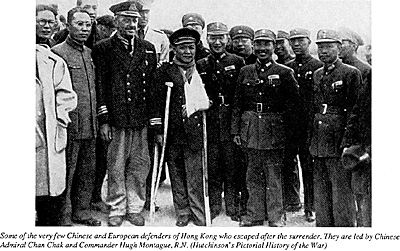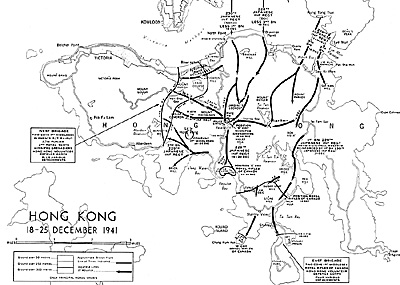
The final assessment?
Some of the very few Chinese and European defenders of Hong Kong who escaped after the surrender. They are led by Chinese Admiral Chan Chak and Commander Hugh Montague, R.N. (Hutchinson's Pictorial History of the War)
General Maltby put British casualties at 4,413, of which 2,113 were killed or missing with at least 400 officer casualties. The Japanese suffered 2,754 casualties, of which 675 were killed. Testimonial to British losses were the final roll call of various units. In part, the Royal Scots were down to 102 men, the Rajput failed to exist as a unit, and the Canadian battalions had suffered 50% casualties.
A final analysis of the campaign would reveal that as individual units, the defenders fought tenaciously and with great resolve; but as a whole unified command they proved uncoordinated and unable to execute any sort of cohesive defense. Time after time the various battalions failed to react as planned, and instead of reacting within an overall plan of operations, units were forced to move in piecemeal fashion. Further, the British, although denied most of their transport, still based their movements along the roads. The Japanese regiments went cross country and often ambushed British road-bound units.
Strategically, it can be determined that Maltby's decision to abandon the mainland so early hastened the fall of Hong Kong. Certainly, the evacuation of Devil's Peak proved especially painful. Next, the intial decision to disperse the battalions along the periphery of the island proved disastrous. Had the Middlesex, in particular, been able to concentrate their forces on a landing site, the Japanese might have been repulsed. To be fair though, all of this would have only delayed the inevitable. The Japanese attacked with determination. They always regrouped from their setbacks and carried the momentum throughout the campaign.
General Sano's forces were comprised of battle-tested veterans of Chinese campaigns. They were experienced with success and fought for it. As proof of their tenacity, these same troops soon saw action in the Netherlands East Indies. The 38 Division eventually met its fate at Guadalcanal and New Guinea. In retrospect, the British defense at Hong Kong did delay Japanese plans elsewhere. But was it worth the price? Did the arrival of the last minute Canadian battalions really made a difference? For Churchill, Christmas 1941 was to be a somber experience.
Bibliography
Vincent, Car. No Reason Why: The Canadian Hong Kong Tragedy. Canada's Wings Inc., 1981.
Ferguson, Ted. Desperate Siege: The Battle of Hong Kong. Nelson Canada Limited, 1981.
Carew, Tim. The Fall of Hong Kong. Pan Books Limited, 1960.
Lindsay, Oliver. The Lasting Honour: The Fall of Hong Kong 1941. Hamish Hamilton, 1978.
Commemoration: Canadians in Hong Kong. Veteran Affairs, 1989.
Map

The Fall of Hong Kong 1941
- Introduction
Japanese Attack: Dec. 8
The Assault on the Island
Final Assessment
Jumbo Map of Attack on Hong Kong (slow: 187K)
Back to Table of Contents: CounterAttack # 4
To CounterAttack List of Issues
To MagWeb Master Magazine List
© Copyright 1993 by Pacific Rim Publishing Company.
This article appears in MagWeb.com (Magazine Web) on the Internet World Wide Web.
Other articles from military history and related magazines are available at http://www.magweb.com